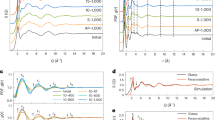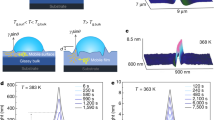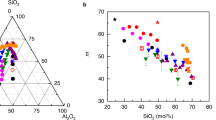Abstract
Entropic elasticity, a property typical of rubbers and well known in organic polymers with appropriate network structures, is not known to occur in oxide glasses1,2. Here, we report the occurrence of entropic elasticity in phosphate-glass fibres with highly anisotropic structures, drawn by mechanical elongation from supercooled liquids. We observed a large lengthwise shrinkage of ~35% for phosphate glasses with an enhanced one-dimensional structure, as well as a distinct endotherm on reheating them up to temperatures between that of the glass transition temperature and the softening temperature. Our results strongly suggest the possibility of designing oxide glasses with a rubbery nature at high temperatures.
This is a preview of subscription content, access via your institution
Access options
Subscribe to this journal
Receive 12 print issues and online access
$259.00 per year
only $21.58 per issue
Buy this article
- Purchase on Springer Link
- Instant access to full article PDF
Prices may be subject to local taxes which are calculated during checkout





Similar content being viewed by others
References
Treloar, L. R. G. The Physics of Rubber Elasticity 3rd edn (Oxford Univ. Press, 2005).
Harper, C. A. Handbook of Plastics and Elastomers: Chap. 1 Fundamentals of Plastics and Elastomers (McGraw-Hill, 1975).
Shang, H. & Rouxel, T. Creep behavior of soda-lime glass in the 100–500 K temperature range by indentation creep test. J. Am. Ceram. Soc. 88, 2625–2628 (2005).
Rouxel, T. Elastic properties and short-to medium-range order in glasses. J. Am. Ceram. Soc. 90, 3019–3039 (2007).
Eisenberg, A., Saito, S. & Sasada, T. Viscoelastic relaxation mechanism of inorganic polymers. V: Counterion effects in bulk polyelectrolytes. J. Macromol. Sci. A 1, 121–134 (1967).
Eisenberg, A. & Takahashi, K. Viscoelasticity of silicate polymers and its structural implications. J. Non-Cryst. Solids 3, 279–293 (1970).
Pelletier, J. M., Perez, J., Duffrene, L. & Sekkat, A. Evidence for a residual elastic modulus in inorganic glasses by mechanical spectroscopy. J. Non-Cryst. Solids 258, 119–130 (1999).
Roundy, D. & Rogers, M. Exploring the thermodynamics of a rubber band. Am. J. Phys. 81, 20–23 (2013).
Eisenberg, A. & Teter, L. A. A relation between the relaxation mechanism and the distribution of relaxation times. J. Polym. Sci. Pol. Lett. 7, 471–475 (1969).
Stockhorst, H. & Brückner, R. Structure sensitive measurements on phosphate glass fibers. J. Non-Cryst. Solids 85, 105–126 (1986).
Brückner, R. Anisotropic glasses and glass melts — A survey. Glastech. Ber. Glass Sci. Technol. 69, 396–411 (1996).
Brow, R. K. Review: The structure of simple phosphate glasses. J. Non-Cryst. Solids 263–264, 1–28 (2000).
Nesbitt, H. W. et al. Bridging, non-bridging and free O2− oxygen in Na2O-SiO2 glasses: An X-ray photoelectron spectroscopic (XPS) and nuclear magnetic resonance (NMR) study. J. Non-Cryst. Solids 357, 170–180 (2011).
Micoulaut, M. & Phillips, J. C. Onset of rigidity in glasses: From random to self-organized networks. J. Non-Cryst. Solids 353, 1732–1740 (2007).
Novita, D. I., Boolchand, P., Malki, M. & Micoulaut, M. Fast-ion conduction and flexibility of glassy networks. Phys. Rev. Lett. 98, 195501 (2007).
Wong, J. & Angell, C. A. Application of spectroscopy in the study of glassy solids, Part II. Infrared, Raman, EPR, and NMR spectral studies. Appl. Spectrosc. Rev. 4, 155–232 (1971).
Meyer, K. Characterization of the structure of binary zinc ultraphosphate glasses by infrared and Raman spectroscopy. J. Non-Cryst. Solids 209, 227–239 (1997).
Nelson, B. N. & Exarhos, G. J. Vibrational spectroscopy of cation-site interactions in phosphate glasses. J. Chem. Phys. 71, 2739–2747 (1979).
Gibbs, J. H. & DiMarzio, E. A. Nature of the glass transition and the glassy state. J. Chem. Phys. 28, 373–383 (1958).
Eisenberg, A. & Saito, S. Possible experimental equivalence of the Gibbs–DiMarzio and free-volume theories of the glass transition. J. Chem. Phys. 45, 1673–1678 (1966).
Kohara, S. et al. A horizontal two-axis diffractometer for high-energy X-ray diffraction using synchrotron radiation on bending magnet beamline BL04B2 at SPring-8. Nucl. Instrum. Methods 467, 1030–1033 (2001).
Greaves, G. N. S. Sen. Inorganic glasses, glass-forming liquids and amorphizing solids. Adv. Phys. 56, 1–166 (2007).
Zarzycki, J. Glasses and the Vitreous State Ch. 9 (Cambridge Univ. Press, 1991).
Duffrene, L., Gy, R., Burlet, H. & Piques, R. Viscoelastic behavior of a soda-lime-silica glass: Inadequacy of the KWW function. J. Non-Cryst. Solids 215, 208–217 (1997).
Suzuki, S., Takahashi, M., Kobayashi, T. & Imaoka, M. Retarded elasticity in B2O3–GeO2 glasses. J. Non-Cryst. Solids 46, 163–169 (1981).
Ya, M., Deubener, J. & Yue, Y. Enthalpy and anisotropy relaxation of glass fibers. J. Am. Ceram. Soc. 91, 745–752 (2008).
Martin, B., Wondraczek, L., Deubener, J. & Yue, Y. Mechanically induced excess enthalpy in inorganic glasses. Appl. Phys. Lett. 86, 121917 (2005).
Hornbøll, L., Lönnroth, N. & Yue, Y. Energy release in isothermally stretched silicate glass fibers. J. Am. Ceram. Soc. 89, 70–74 (2006).
Acknowledgements
A part of the present research was supported by the fund from the MEXT Element Strategy Initiative to form core research centres. We would like to thank S. Kohara and H. Tajiri (Japan Synchrotron Radiation Research Institute, JASRI), Y. Benino (Okayama University), and N. Shimizu and H. Takagi (High Energy Accelerator Research Organization, KEK) for insightful discussions. High-energy X-ray diffraction experiments were performed at the BL04B2 beamline of SPring-8 with the approval of the Japan Synchrotron Radiation Research Institute (Proposal No. 2014A1096).
Author information
Authors and Affiliations
Contributions
S.Inaba and S.Ito designed and ran the experiments and analysed the data. All authors discussed the results, commented on the study and co-wrote the manuscript.
Corresponding author
Ethics declarations
Competing interests
The authors declare no competing financial interests.
Supplementary information
Supplementary Information
Supplementary Information (PDF 1202 kb)
Supplementary Information
Supplementary Movie S1 (MOV 629 kb)
Supplementary Information
Supplementary Movie S2 (MOV 840 kb)
Rights and permissions
About this article
Cite this article
Inaba, S., Hosono, H. & Ito, S. Entropic shrinkage of an oxide glass. Nature Mater 14, 312–317 (2015). https://doi.org/10.1038/nmat4151
Received:
Accepted:
Published:
Issue Date:
DOI: https://doi.org/10.1038/nmat4151
This article is cited by
-
Formation of metallic cation-oxygen network for anomalous thermal expansion coefficients in binary phosphate glass
Nature Communications (2017)



